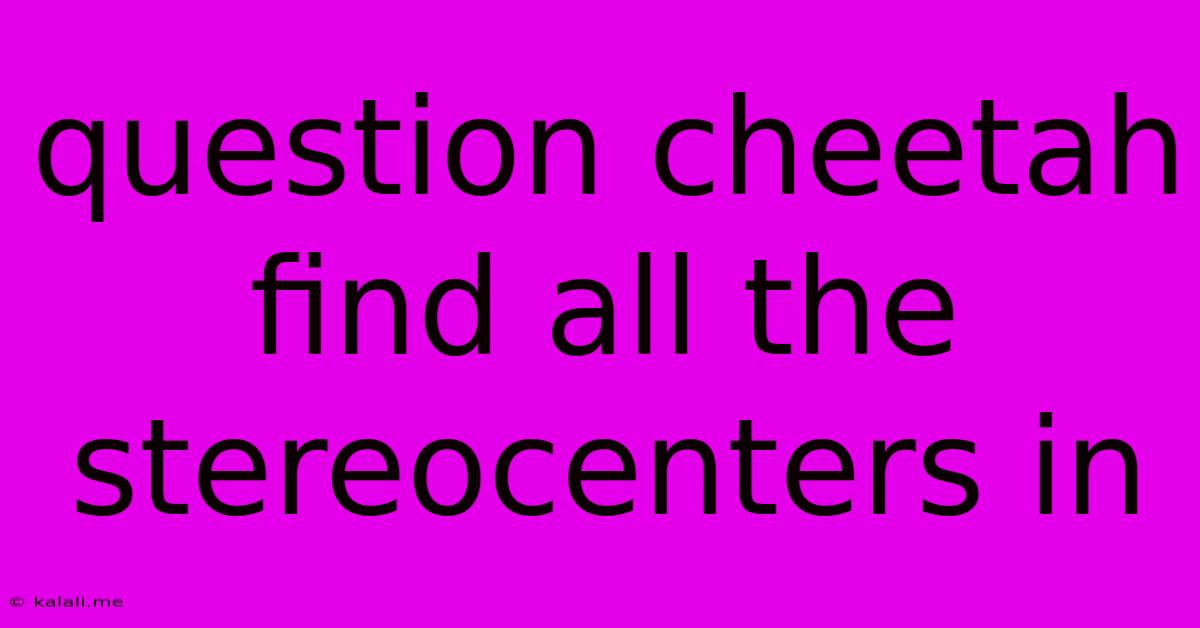Question Cheetah Find All The Stereocenters In
Kalali
Jun 06, 2025 · 3 min read

Table of Contents
Finding All Stereocenters: A Cheetah's Guide to Chirality
Identifying stereocenters is a fundamental skill in organic chemistry. This article will guide you through a step-by-step process to confidently locate all stereocenters within any given molecule, much like a cheetah's precision in its hunt. Understanding chirality and stereocenters is crucial for predicting the properties and reactions of molecules. We'll cover the definition, the rules for identification, and some helpful tips and tricks.
What is a Stereocenter?
A stereocenter (also known as a chiral center) is an atom in a molecule that has four different groups attached to it. This asymmetry results in the molecule having non-superimposable mirror images, called enantiomers. These enantiomers possess identical physical properties except for their interaction with plane-polarized light and their behavior in chiral environments. Think of it like your left and right hands: they are mirror images but not superimposable.
Rules for Identifying Stereocenters:
-
Identify all tetrahedral atoms: Look for atoms with four single bonds (sp³ hybridized). Carbon is the most common stereocenter, but other atoms like silicon, nitrogen, phosphorus, and sulfur can also be stereocenters if they meet the criteria.
-
Check for four different groups: Examine each tetrahedral atom. If all four groups attached to the atom are different, then that atom is a stereocenter.
-
Ignore double and triple bonds: Double and triple bonds don't contribute to stereocenters because they involve different bonding arrangements.
-
Consider isotopic substitution: Atoms with different isotopes (e.g., ¹²C vs. ¹³C) are considered different groups.
Example: Identifying Stereocenters in a Molecule
Let's consider a simple example to illustrate the process. Imagine a molecule with a carbon atom bonded to a methyl group (-CH₃), a hydroxyl group (-OH), a hydrogen atom (-H), and a bromine atom (-Br). This carbon atom fulfills the criteria for a stereocenter because it has four different groups attached.
Advanced Considerations and Challenges:
-
Multiple Stereocenters: Molecules can have multiple stereocenters. The number of possible stereoisomers increases exponentially with the number of stereocenters (2<sup>n</sup>, where n is the number of stereocenters).
-
Meso Compounds: Some molecules with multiple stereocenters possess an internal plane of symmetry, making them achiral despite containing stereocenters. These are called meso compounds. They are optically inactive.
-
Complex Molecules: In larger, more complex molecules, carefully and systematically checking each tetrahedral atom is crucial to avoid missing any stereocenters.
Tips and Tricks for Efficient Identification:
-
Systematic approach: Work your way through the molecule, atom by atom, systematically checking each tetrahedral atom.
-
Visual aids: Drawing the molecule clearly and using 3D models can be very helpful.
-
Practice: The best way to master stereocenter identification is through practice. Work through various examples to build your confidence and skill.
By following these steps and practicing regularly, you will become proficient in identifying stereocenters and understanding the chirality of molecules. Remember, like a cheetah pursuing its prey, a systematic and precise approach is key to success in organic chemistry!
Latest Posts
Latest Posts
-
Kansas City Vs New York Strip
Jun 07, 2025
-
How Do You Make A Window Screen
Jun 07, 2025
-
How To Replace A Ceiling Fan With A Light Fixture
Jun 07, 2025
-
Standard Sphere Grid Vs Expert Sphere Grid
Jun 07, 2025
-
Hwo To Make Asm Code Start At Specific Label
Jun 07, 2025
Related Post
Thank you for visiting our website which covers about Question Cheetah Find All The Stereocenters In . We hope the information provided has been useful to you. Feel free to contact us if you have any questions or need further assistance. See you next time and don't miss to bookmark.